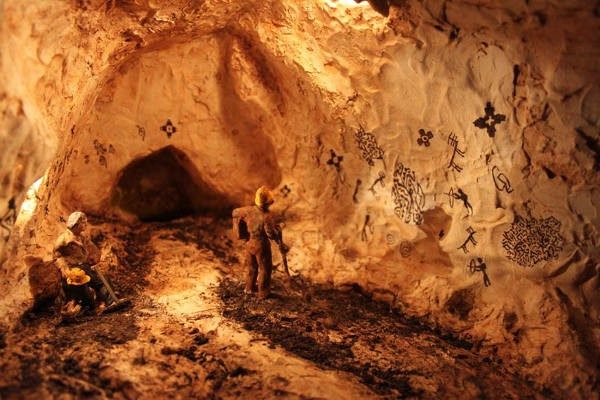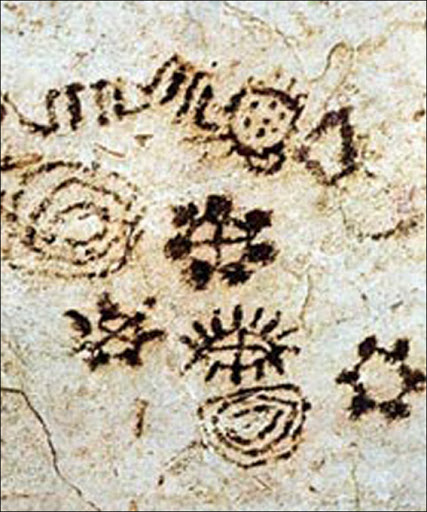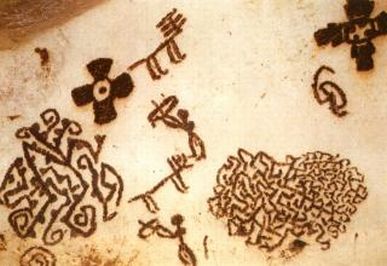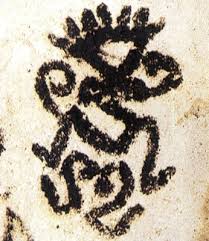#grottadeicervi #portobadisco #salento #extraterrestrial #pictograms #cave

Inside speleologists found rock paintings of the first inhabitants of the area who lived there 6 millennia ago, according to archaeological ricostructions. Studies on wall lasted more than 10 years and stated these paintings as
“the most important and qualitatively most impressive post-paleolithic wall painting art complex known in Europe […] enclosed in a single cave“.

The red and black paintings depict hunting scenes, deer and other signs of difficult interpretation. The place is not officially open to the public so as not to disturb the particular microclimate of the cave and thus preserve the paintings. Among the pictograms there is one that depicts a cruciform celestial body with a sort of cockpit in the center and elsewhere hominids with their weapons who destroy villages and kidnap the inhabitants.

What do these signs mean? What ancient memory do they tell? Is the closure of the cave linked to the desire to keep these paintings hidden? The speleologist Isidoro Mattioli who was among the group of discoverers returned to the cave other times to never return because, he says, during the explorations he heard the roar of rolling stones and the sound of drums.
The legend of the Shaman of Messapia
A new legend inflated by followers of extraterrestrial theories tells that 5 millenia ago, the same period of paintings, the Salento was a lush and mysterious land, rich in water and life, of immense forests with huge tall trees and a fertile undergrowth populated by wild boars, deer and magnificent moose. The planetary assembly of the gods met periodically near the sulfur springs, generated by the disintegration of the bodies of the Titans, massacred by Heracles with the help of Zeus. Every hundred years, a great multitude of picturesque deities discussed the problems and destinies of humanity. The result of each meeting of the planetary divinities was fixed on ideograms and pictograms impressed on the walls of the main caves along the coast.

During the first assembly of the fifth millennium BC they decided the fate of the weaver Aracne and the Shaman of Messapia (probably portrayed in this pictogram), who were confined into the Grotta dei Cervi. The Messapian Shaman was a beautiful and very intelligent man, who wanted to refute the methods and treatments of the god Asclepius.
He proposed to obtain healing from illness and even to guarantee the resurrection of death with the help of faithful snakes and the magical effect of the blood of the Medusa, the Gorgon, which he had exchanged for his own with the help of Athena.
Asclepius, in revenge, proposed to wall him alive in the Grotta dei Cervi . But Arachne, who loved the shaman, offered him a huge polygonal canvas as a gift, which would be used to shelter from the cold and humidity of the cave. When Asclepius learned of this, he reached the cave angry, horribly deforming the shaman’s features and fixing him like a pictogram on the cave walls; moreover, the furious divinity reduced the cloth lovingly woven by Arachne to a thousand pieces and deposited his apparently useless rags (zinzuli) in a cave to the south, which for this reason took the name of Grotta Zinzulusa.
If this seems to be only a legend, we suggest you to have a look on the many pictograms and paintings in many caves whose signs remember Ufo and spacecraft and peolple with an helmet. To be continued…
Last articles
- Orecchiette with Cime di Rapa (broccoli rab)
- The hidden river
- La nascita delle Orecchiette
- Il grano Senatore Cappelli
- Apulian Menù. The Orecchiette with brasciole
or choose a category
Apulia Bari città d'arte Puglia cosa vedere in cosa vedere in Puglia cosa vedere in Salento cosa vedere ostuni cose interessanti da vedere curiosity curiosità doc eng eros eros di altri tempi Europa extravergine fischietti frisa frise frise al pomodoro friselle friselle al pomodoro la città bianca Lecce mare in salento miti Miti e leggende del Salento miti e leggende Salento oil olio olive oil Orecchiette Ostuni otranto Puglia salento sapori storie Storie sulla Puglia storie sul Salento terra d'otranto Valle d'Itria visita Puglia visit Puglia viviere il Salento